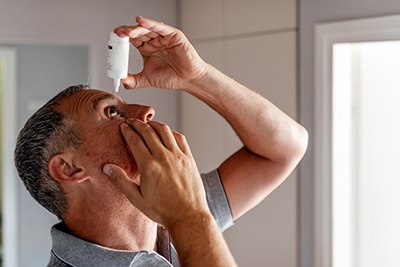Section 3: Examples of Vision and Eye Health Interventions
The 2016 report Making Eye Health a Population Health Imperative: Vision for Tomorrowexternal icon notes that population health strategies can improve vision and eye health in the United States and globally.4 Public health agencies can implement a range of strategies to promote vision and eye health. For example, strategies can be implemented to:
- Promote public awareness of the importance of vision and eye health.
- Expand access to appropriate clinical care.
- Build public health capacity to support vision-related activities.
- Promote community actions that enhance vision and eye health.
The remainder of this section of the toolkit describes interventions that have been used in the public health sector to promote vision and eye health.
Interventions to Promote Awareness of Vision and Eye Health Issues
Awareness of vision and eye health and associated health risks can help motivate people to take the necessary steps to protect their vision and eye health. Examples of interventions designed to promote awareness of vision and eye health issues include the following:
- The Stopping Elderly Accidents, Deaths, and Injuries (STEADI) Initiative is a CDC program that provides health care providers with strategies and tools to help them implement fall prevention interventions. Vision health is integrated into this intervention because vision plays an important role in fall prevention among older adults.
- Pharmacy, Podiatry, Optometry, and Dentistry (PPOD) was a program in CDC’s National Diabetes Education Program. It was designed to engage providers from these four disciplines to work together to actively identify and treat patients with diabetes. This team-based approach can significantly reduce patients’ risk of developing diabetes complications, including blindness.
- The Lions Eye Health Programpdf iconexternal icon is a community education program that helps Lions Clubs, community organizations, and individuals promote healthy vision and raise awareness of the causes of preventable vision loss. The program works to empower communities to save sight through early detection and timely treatment of diabetic eye disease, glaucoma, and age-related macular degeneration.
- The Oklahoma Healthy Aging Initiativeexternal icon offers a class for older adults called “Eye Ball 101” that provides a comprehensive overview of eye health and medical conditions that affect eyesight.
- The National Eye Health Education Programexternal icon was established by the National Eye Institute. It provides a variety of resources to increase awareness of eye health. Program resources are designed to help reach populations at high-risk of eye disease and vision loss and to promote the use of vision rehabilitation services.
Interventions to Promote Access to Vision and Eye Care for Populations at Risk
Vision impairment and eye disorders can often be prevented if people have access to vision and eye care services. Access to preventive services is especially important for people at higher risk of vision impairment and those who have difficulty accessing health care services due to geographic or financial constraints.

Several reputable and accredited organizations have used evidence collected from scientific research to develop evidence-based recommendations and guidelines related to vision and eye health. Examples of these recommendations include the following:
- Regular eye exams for adults aged 60 or older, which is supported by the American Optometric Association (AOA), American Academy of Ophthalmology (AAO), American Academy of Family Physicians, and American College of Obstetricians and Gynecologists.
- Annual comprehensive eye exams for people with diabetes to allow for early detection and management of diabetic eye diseases, which is supported by the American Diabetes Association, AOA, and AAO.
- Regular comprehensive medical eye evaluations for adults at risk of developing glaucoma, which is supported by AOA and AAO.
- Vision screening at least once for all children aged 3 to 5 years to detect amblyopia (also called lazy eye) or its risk factors, which is supported by the US Preventive Services Task Force.
Examples of interventions designed to promote access to and use of vision and eye care services include the following:
- The Kirby Puckett Eye Mobileexternal icon is a mobile eye clinic that provides free vision screenings to people of all ages in communities across Minnesota. It also provides comprehensive eye exams, eye health information, and referrals to vision and eye care resources.
- Vision To Learnexternal icon is a nonprofit organization that partners with school districts throughout the United States. It uses mobile eye clinics to provide free eye exams and glasses to children in low-income communities.
- Alabama Lions Sightexternal icon is a mobile eye clinic that provides vision and eye care services, including vision screenings, at several sites in the most rural areas of Alabama.
- Prevent Blindness North Carolinaexternal icon found that low-income, older, African American women were less likely than other population groups to receive vision and eye care services. They partnered with CDC’s WISEWOMAN program to include vision screening as part of preventive health screenings offered to low-income women in rural parts of the state.
- Prevent Blindness Wisconsinexternal icon conducts training throughout the state to ensure that public health practitioners can educate the public about the importance of vision and eye care and the eye conditions that can affect older adults. The program, called Healthy Eyes, teaches participants about age-related macular degeneration, cataract, glaucoma, and diabetic retinopathy.
- Prevent Blindness Ohioexternal icon partners with the Ohio Department of Health on the Wise About Eyes Programexternal icon. This program provides vision screening certification and equipment to primary medical clinics, school nurses, Head Start staff, and other providers to ensure that children aged 3 years or older receive evidence-based vision screenings.
- Enterprise-Wide Initiativesexternal icon are telehealth interventions under the Office of Rural Health in the US Department of Veterans Affairs. They place ophthalmology technicians in rural Veterans Affairs (VA) clinics that lack vision and eye screening services. The technicians transmit patient eye information to VA ophthalmologists for diagnosis and follow-up.
- The University of Virginia Health Systemexternal icon is expanding its use of telemedicine to help patients across Virginia better prevent or manage chronic conditions. Through its Center for Telehealth, the system is piloting an intervention to use telehealth technologies to screen patients for diabetic retinal disease.
- The Children’s Vision Screening Initiativeexternal icon is offered through the Northern Plains Eye Foundation in South Dakota. It provides free annual vision screening to children in preschool and elementary school. It also provides sight-saving surgeries to help people regain their vision, mobility, and quality of life.
- Project BEST: Better Eye-Health Services and Treatmentexternal icon is provided through the Commission for the Blind and Visually Impaired in the New Jersey Department of Human Services. It offers vision screening services to children, adults, and migrant workers. It also focuses on helping historically underserved populations, including people who are low-income, elderly, are members of minority groups, or have diabetes.
- Friends for Sightexternal icon is a nonprofit organization in Utah that provides vision screenings for children, glaucoma screenings for adults, free eye exams and glasses to low-income children, and education about eye safety and eye health.
- Helen Keller International ChildSightexternal icon is a nonprofit organization that provides free in-school vision screenings, prescription eyeglasses, and referrals to local community vision and eye care providers to children in low-income communities. It currently operates in California, Minnesota, New Jersey, New York, Ohio, and Wisconsin.
- The Wills Eye Glaucoma Research Centerexternal icon in Philadelphia developed and evaluated a community vision and eye care delivery modelexternal icon that provides eye exams and educational workshops in an urban area to detect, treat, and manage glaucoma in people at high-risk of developing this condition. The evaluation showed the value of using community strategies to reach people with glaucoma or suspected glaucoma in a metropolitan area.
- Eye Care Quality and Accessibility Improvement in the Community (EQUALITY)external icon is a telemedicine program focused on glaucoma detection and management. It was established by the University of Alabama at Birmingham. The program is used in retail-based primary care practices that serve communities with a high percentage of people at risk of glaucoma. An evaluation of the project found that when people know more about glaucoma and plan to get vision and eye care services, it may result in early detection of disease and lower risk of vision loss.
Interventions to Promote Rehabilitation and Improve Quality of Life for People With Vision Impairment and Eye Disorders
Rehabilitation interventions seek to improve the quality of life for people with vision impairment by helping them make the most of their remaining vision. These interventions give rehabilitation professionals and organizations the tools they need to improve the functional abilities of people with vision impairment or eye disorders. These tools can help people with vision impairment by increasing their mobility, access to information, number of social contacts, and ability to get and keep a job.

Examples of interventions designed to promote rehabilitation and improve quality of life for people with vision impairment and eye disorders include the following:
- The Community Services for Vision Rehabilitationexternal icon is a nonprofit community organization that uses a mobile eye clinic to provide accessible and comprehensive vision and eye care services to people with low vision and blindness.
- The Minnesota Aging Eyes Initiativeexternal icon was developed by the Minnesota State Services for the Blind. It helps older adults adjust to vision loss by providing low vision aids and devices at no charge. It also provides information about eye conditions common to older adults (e.g., macular degeneration, diabetic retinopathy) and referrals to other necessary health care services.
- The Ohio Department of Agingexternal icon is a state agency responsible for coordinating programs and services under the federal Older Americans Act. It delivers practical, person-centered interventions and services in a variety of areas, including vision and eye health, to strengthen and support Ohio’s older adults and their communities.
- A literature review to assess the effectiveness of providing reading aids to adults with low vision found insufficient evidence to support the use of a specific type of electronic or optical device. The review found some evidence that stand-mounted electronic devices may improve reading speed better than optical devices.5
- A randomized controlled trial of a low vision rehabilitation intervention that used home visits to improve visual function found preliminary evidence that such programs can have a positive influence on vision-related function.6
A comprehensive and thoughtful intervention can improve vision and eye health in your state or community. As you plan and implement your intervention, consider the extent to which your intervention is based on best practices or scientific evidence, can be used in different settings, and engages the community. You will also need to evaluate your efforts.
